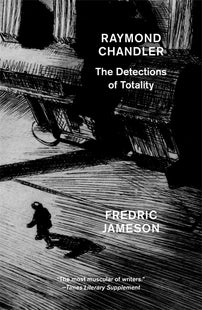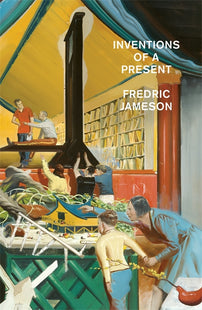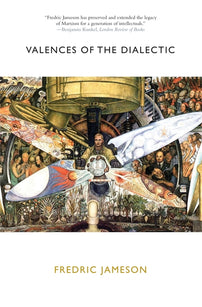Uncompromising Dialectics
For our Jameson at 90 series, Oded Nir writes about Fredric Jameson's Raymond Chandler and the presence of totality in art.

Jameson’s book on Chandler is one of the best demonstrations of a simple truth: that totality in art is a name for the dialectic of closure, and, as such, it doesn’t have a predetermined itinerary, but is rather constituted by the movement of thought through the artwork. In this movement, every detail is not merely contrasted to other particulars; nor is it merely judged in its conformity to some generality. Rather, every detail is seen in light of the very interaction between the artwork’s general construction and its particulars. As such, there is nothing less reductive, less sealed off to the matter at hand, than the presence of totality in art.
In fact, one can see the three chapters of Jameson’s book as three conceptual approximations, three ways of asymptotically trying to wrest totality from Chandler’s literary form in its most minute detail. And, if detail itself—as detail, rather than as dominant content or form—is the most apparent challenge to totality, then that is precisely the problematic dealt with in the first chapter, demonstrating how in the most unimportant detail totality is captured, down to Chandler’s very language: “The problem of slang [in Chandler] forms a parallel in the microcosm of style to the problem of the presentation of the serial society itself, never present fully in any of its manifestations… offering the impossible alternative between an objective and abstract lexical knowledge of it as a whole and a lived concrete experience of its worthless components”(14).
The movement of Jameson’s writing in this chapter is uncompromisingly dialectical, in moving through these incongruent encounters between detail and some thematization of the whole of society: in the example above, slang encounters serialized society; in another instance, meaningless objects in a Chandler’s novel provides Jameson with the occasion for quick but all-encompassing periodization of the transformation of our attitudes to the world of produced objects (in which nascent is Jameson’s theorization of postmodernism, not yet fully formed). All of these are instances of the same paradox, “of something slight in density and resonance being at the source of some incomparably larger solid, of a kind of nothingness creating being, of a shadow projecting three-dimensionality out from itself.”
[book-strip index="1"]
The end point of this (very Adorno-esque) strategy for making totality appear is the frustration of the temporal plot of the detective novel. Reconstructing the murder plot ends up resolving into an old affair, concluded long ago and ultimately unsatisfying. It ends up being just another unimportant detail—but one crucial for the shill game of Chandler’s novels: it is what you think interests you, but it isn’t. You may feel briefly cheated, but then you start perceiving where the novel’s actual thinking takes place: in its spatial logic. The absolute limit of the temporal plot, what it cannot think directly but points toward, is its opposite—the spatial thinking of the works.
It is this passage to spatiality that makes it finally possible to go beyond the frustrating parallax of the first chapter, between useless detail and already-available scientific knowledge of society, in making totality appear. In the second chapter, then, literary figures themselves start generating concepts and analytical structures; what is emphasized here is how the dialectic masters structuralism, or semiotic oppositions structured by the novels themselves. As Jameson has it, spatiality turns our attention to dwellers and their dwelling, and our journey into it begins with the first chapter of The Big Sleep. The encounter with characters’ visuality allows for a mapping of them onto a Greimassian rectangle (36). One of the oppositions of this rectangle—the public/private divide—is then developed into a whole semiotic system, a combinatoire of characters and their spaces, in which we find distinctions between those who “have their offices in their homes” and that type of character whose ‘home’ is his ‘office’” (46). The former, in Chandler’s novels, are all kind of questionable doctors and others who cater to the needs of the rich; the latter are predominantly male sex workers. Both of which are to be distinguished from those who have homes and no office (either the very rich or very poor) or those who have an office but no home (which, surprisingly, is reserved for Chandler’s policemen).
But again: something must borrow what it isn’t to seem whole. Here, something else must be present to generate the totality effect, overlaying the logical typology of spaces, which remains too mechanistic and arbitrary. The natural landscape--uniquely perceptible in Los Angeles’s urban setting—is the answer: “closure in Chandler's novels is achieved by something like the projection of the axis of geography or nature onto that of society; and that the intermeshing of these two codes or systems allows for the transfer of closure as such from the vaster totality of the natural landscape to the far more questionable and purely logical systematization of the social order (51). At every point, Jameson brilliantly demonstrates, as if unimportant descriptions of the outside, the natural setting, are provided to validate, as it were, the social typology.
[book-strip index="2"]
The third and final chapter is all about Chandlerian nature and breaking free of the structuralist prison house; but here one must think about nature in terms of an ultimate register of interpretation—the place that in The Political Unconscious is reserved for the unrepresentable mode of production itself. If in the previous chapter, nature was what made legitimately whole a semiotic system of social distinctions, the situation here is the opposite: Nature provides “a more general critique of semiotics as such, as a system which is capable of including or processing certain kinds of materials of a uniform type, whether these be semes or realities. Such a critique of semiotics would … lead the critic …to designate conceptualities or reflexivities, negativities, absences, which do not register on the essentially positivistic apparatus of the semiotic recording device” (74). Jameson uses Heidegger’s notion of Earth—as that which always remains outside History—to designate this stronger negation.
The dialectical force of the argument here resides in trying to conceptualize the way in which Chandler’s novels register that dimension of Earth or Nature, to poetically designate that which ultimately resists signification. Each novel does it a differently. In Farewell My Lovely, it is the sea itself: “the liquid element is here not within the narrative world, not a part of its semiotic system, but rather what lies beyond it and cancels it as such.”
One should insist on the uncompromising paradoxical status of such narrative barriers: they give expression to an intuition of what must remain undetectable from the inside human perception; they say something felt, but ultimately without basis. The movement of Jameson’s own writing wrestles with this dialectical paradox: “The sea is here cleansed even of otherness; and it would be tempting to associate it with death itself…But even this strikes me as a sentimentalism, and the attribution of an inner-worldly content to a non-space whose very function itis--anti-semiotic yet poetic all at the same time--very precisely to revive even the word death and to lend it a specific and hauntingly Chandlerian tone” (84).
Closure, or totality, comes therefore to rest with this well-nigh impossible inclusion of such barriers inside what cannot include them. One may think that the Heideggerian framing of the problem, as one in which History is limited by Nature, is something of a non-Marxist moment in Jameson: where is the mode of production as the final horizon of interpretation? But, then again, isn’t the crisis of historicity—the failure to produce some imagined relation to unrepresentable History, or the mode of production, the attempt to signify our inability to imagine history as collective practice—precisely the point of Postmodernism?
See all works by Fredric Jameson here. His new book, Inventions of a Present: The Novel in its Crisis of Globalization is out on May 7.
[book-strip index="3"]




